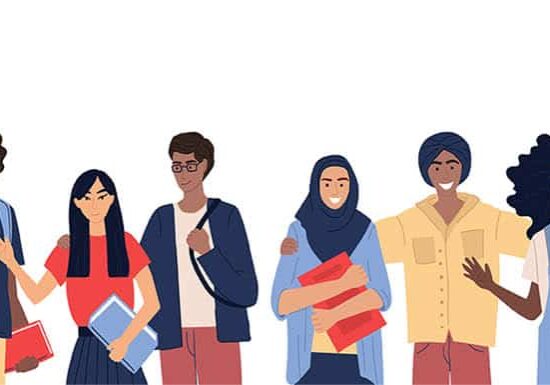The Undeniable Importance of Diversity in Higher Education
Updated: January 17, 2024
Published: October 8, 2021

The total number of students enrolled in higher education is expected to reach 594 million in 2040 due to the growth in demand for higher education. But, when you look at higher education in the past and present, there is clearly underrepresentation of minorities. In America alone, the data shows that students of color are underrepresented along the educational journey, including at application, admission, and completion of degrees. The importance of diversity in education is undeniable.
Let’s explain the benefits of diversity in education, as well as share ideas on how to achieve this goal. We’ll also take a look at some staggering statistics that showcase the current problem and need for change.

Benefits of Diversity in Education
When thinking about diversity, there’s more than race to consider. Diversity also refers to differences in gender, economic background, religion, and even learning styles. Promoting inclusion can result in a better educational experience for everyone involved.
Some benefits of diversity in education include:
Better performance
Studies have proven that students who learn in diverse environments tend to perform better. When there are students from different backgrounds working together, students feel the urge and motivation to push forward and do their best. Not only do various perspectives contribute to better problem-solving abilities, but it also adds an unparalleled level of creativity into the mix.
Feeling of belongingness
Students who can learn with people that they can relate to will feel a sense of belonging. When students feel comfortable in their environment, they are more likely to speak up and feel safe to ask questions. When someone feels isolated and alone, they are less likely to contribute to the group, which could also result in lower confidence levels.
Preparation for diverse workplaces
The world is a diverse place. As such, students pick up many of their life and professional skills while in college. By engaging in an environment that mimics what they can expect to experience in their work settings, they are being prepared for real life. Not only is there diversity within professional settings, but the rise of technology and globalization makes it inevitable that people will communicate with others outside of their culture when working. That’s why learning these skills before entering the working world will prove so beneficial over time.
Enhances creativity
Having exposure to diverse thoughts, opinions, and cultural backgrounds supports creativity of thought and action. It provides an environment in which open-mindedness is cherished rather than suppressed. The more ideas and experiences that a person takes part in, the more able they are to use various perspectives when approaching a task or solving a problem.
Improves critical thinking skills
In life, it’s easy to accept things as they are without question. When someone grows up in an environment surrounded by people who are similar to them, they only get to learn one way of thinking or doing. But, with diversity in a classroom, students can consider ideas, cultural perspectives, and opinions of those who come from different backgrounds. This can prompt people to question what they have grown up believing and improve critical thinking skills.
Underrepresentation in Higher Education Still Exists
It may be hard to believe that underrepresentation and lack of diversity still exists in higher education, but unfortunately, it is still the case.
Consider America, the world’s melting pot, as an example. Statistics show that:
- The number of black graduates in tech programs is declining even as demand is increasing.
- Although people of color declare STEM majors at about the same rates as their white peers, the gap occurs at graduation when 58% of white students earn their degree, compared with just 43% of Hispanic students and 34% of black students.
- This translates into lower workforce diversity. Black people represent 7% of the workforce in STEM jobs that require bachelor’s degrees, even though that’s just half their proportion in the population.
- The gap in college opportunity for students of color and white students is growing, even as diversity in America also grows. For example, between 1974-2014, the gap between white and Hispanic students earning their bachelor’s degree more than doubled, from 9% to 20%.
How to Foster Diversity in Education
Other than policies that work to lessen the opportunity gap in higher education, there are ways in which teachers, administrators, and students within educational institutions can promote and support diversity in education.
Here are a few ideas:
Review teaching materials
Teaching materials, especially in humanities and social sciences, often default to a white, male, and middle-class narrative. Ensure that you are representing different voices by choosing diverse resources and reading materials.
Get to know students
Teachers and professors can spend time learning about their student population. This is easy to do by simply taking a look around the room and making note of the diverse faces. But, it extends deeper than that. You can design assignments that honor diversity and allow students to share their unique perspectives.
Address inequality
There’s always an elephant in the room when differences remain unacknowledged. Create a safe space for students to talk about feelings of discrimination that they may have experienced. The more open you are to addressing it, the more likely students will feel comfortable talking about it so that solutions can occur to resolve any issues.
Hire diverse people
Importantly, those in teaching positions and administrative positions should represent the students that they serve. Hiring diversity is a key to ensuring that students of all backgrounds feel comfortable attending the institution.

University of the People’s Unique Model
At University of the People, our accredited university operates entirely online. In an effort to support the accessibility and affordability of higher education to students from all over the world, we are a tuition-free institution.
By being both tuition-free and online, we remove geographic and financial barriers of entry. This has resulted in hundreds of thousands of students enrolling in our degree programs from over 200 countries and territories around the world. Hence, a diverse student population that gets to work together to achieve their dreams.
Students from all different walks of life learn together and communicate via online forums and discussions that promote the sharing of diverse perspectives, learning styles, and opinions.
Final Thoughts
Diversity in education should be a key tenet of all institutions of higher education. By addressing underrepresentation, institutions can create environments in which students from myriad backgrounds get to learn together, share ideas, and expand their horizons.
The benefits within the classroom follow graduates into workplaces and practical life settings to support a world in which diversity is both honored and desired.
